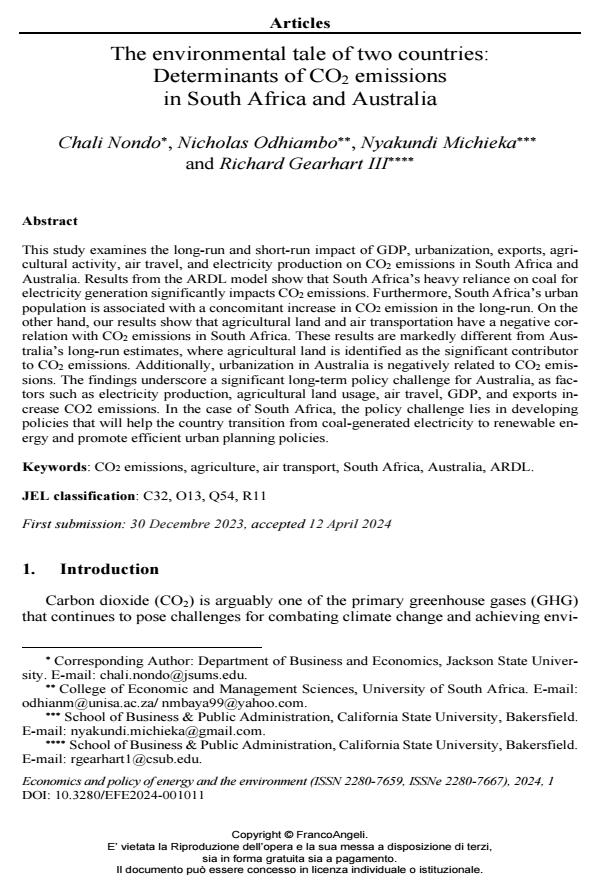The environmental tale of two countries: Determinants of CO2 emissions in South Africa and Australia
Titolo Rivista ECONOMICS AND POLICY OF ENERGY AND THE ENVIRONMENT
Autori/Curatori Chali Nondo, Nicholas Odhiambo, Nyakundi Michieka, Richard Gearhart III
Anno di pubblicazione 2024 Fascicolo 2024/1
Lingua Inglese Numero pagine 25 P. 193-217 Dimensione file 319 KB
DOI 10.3280/EFE2024-001011
Il DOI è il codice a barre della proprietà intellettuale: per saperne di più
clicca qui
Qui sotto puoi vedere in anteprima la prima pagina di questo articolo.
Se questo articolo ti interessa, lo puoi acquistare (e scaricare in formato pdf) seguendo le facili indicazioni per acquistare il download credit. Acquista Download Credits per scaricare questo Articolo in formato PDF

FrancoAngeli è membro della Publishers International Linking Association, Inc (PILA)associazione indipendente e non profit per facilitare (attraverso i servizi tecnologici implementati da CrossRef.org) l’accesso degli studiosi ai contenuti digitali nelle pubblicazioni professionali e scientifiche
This study examines the long-run and short-run impact of GDP, urbanization, exports, agricultural activity, air travel, and electricity production on CO2 emissions in South Africa and Australia. Results from the ARDL model show that South Africa’s heavy reliance on coal for electricity generation significantly impacts CO2 emissions. Furthermore, South Africa’s urban population is associated with a concomitant increase in CO2 emission in the long-run. On the other hand, our results show that agricultural land and air transportation have a negative cor- relation with CO2 emissions in South Africa. These results are markedly different from Australia’s long-run estimates, where agricultural land is identified as the significant contributor to CO2 emissions. Additionally, urbanization in Australia is negatively related to CO2 emis- sions. The findings underscore a significant long-term policy challenge for Australia, as fac- tors such as electricity production, agricultural land usage, air travel, GDP, and exports in- crease CO2 emissions. In the case of South Africa, the policy challenge lies in developing policies that will help the country transition from coal-generated electricity to renewable energy and promote efficient urban planning policies.
Parole chiave:CO2 emissions, agriculture, air transport, South Africa, Australia, ARDL.
Jel codes:C32, O13, Q54, R11
Chali Nondo, Nicholas Odhiambo, Nyakundi Michieka, Richard Gearhart III, The environmental tale of two countries: Determinants of CO2 emissions in South Africa and Australia in "ECONOMICS AND POLICY OF ENERGY AND THE ENVIRONMENT" 1/2024, pp 193-217, DOI: 10.3280/EFE2024-001011